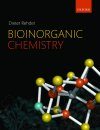![Bioinorganic Chemistry Bioinorganic Chemistry]()
Click to have a closer look
About this book
Contents
Customer reviews
Biography
Related titles
About this book
Bioinorganic chemistry lies at the interface of inorganic chemistry and biochemistry, and explores the function of inorganic species in living systems - from the iron that helps our red blood cells transport oxygen to our tissues, to the calcium that forms an integral part of our bones. In his book, Rehder provides a broad overview of this dynamic field, reviewing the key chemical elements that have important biological function, and exploring how the chemistry of these elements is central to the function of biological systems. With sidebars that both review underlying principles of importance to the subject - including the concepts of magnetism and chirality - and discuss some of the analytical approaches that have enabled us to elucidate the biological role of the chemical elements, Bioinorganic Chemistry is the ideal resource for those discovering the field for the first team, and who need a clear, balanced account of the subject. The Online Resource Centre to accompany Bioinorganic Chemistry features figures from the book in electronic format, for use in lecture slides and other teaching materials.
Contents
Introduction
1: Bio-Elements in the Periodic Table
2: Pre-Life and Early Life Forms, and Extremophiles
3: The Alkaline and Alkaline Earth Metals
3.1: Overview
3.2: Ion Channels and Ion Transport
3.3: Sodium and Potassium
3.4: Magnesium
3.5: Calcium
3.5.1: Calcium Ions as second messenger
3.5.2: Calcium Ions as second messenger
3.5.3: Mineralized calcium
4: Mineralized calcium
4.1: General, and Aqueous Chemistry
4.2: Mobilization, Transport, Storage, Delivery, and Mineralization of Iron
5: Electron Transport by Iron Proteins, and the Reduction of Oxygen
5.1: Overview
5.2: The mitochondrial respiratory chain
5.3: The mitochondrial respiratory chain
6: Classification of Copper Proteins (Overview)
7: Oxygen Transport and Storage
7.1: Oxygen species
7.2: Oxygen transport (and storage) proteins Myoglobin and hemoglobin
8: Oxygenases, Oxidoreductases, Peroxidases and Dismutases
8.1: Overview and Definitions
8.2: Cytochrome P450
8.3: Copper-Based O2-Metabolizing Enzymes
8.3.1: Tyrosinase and catechol oxidase
8.3.2: Cu,Zn-Superoxidedismutase
8.3.3: Galactoseoxidase
8.4: Iron-Based Oxygenases
8.5: Oxo-Transfer Proteins Based on Molybdenum, Tungsten and Vanadium
8.5.1: Molybdo- and tungstopterins
8.5.2: Vanadate-dependent peroxidases
9: The Sulfur Cycle
10: The Nitrogen Cycle
10.1: Overview, and Native Nitrogenase
10.2: Overview, and Native Nitrogenase
10.3: Denitrification
10.4: Nitric Oxide
11: Methanogenesis and Nickel Enzymes; Methanotropism
11.1: Methanogenesis
11.2: Methanotropism
11.3: Methanotropism
11.3.1: Ureases
11.3.2: Nickel Containing Hydrogenases
11.3.3: Acetylcoenzyme-A Synthase
11.3.4: Acetylcoenzyme-A Synthase
12: Photosynthesis
12.1: Overview
12.2: The Light Reaction
12.2.1: Chlorophylls and the water oxidase (Oxygen Evolving Centre, OEC)
12.2.2: Chlorophylls and the water oxidase (Oxygen Evolving Centre, OEC)
12.3: The Electron Transfer Chain and the Dark Reaction
12.4: Artificial Photosynthesis
13: The Biochemistry of Zinc
13.1: General and overview
13.2: Enzymes
13.2.1: Ligases and synthases
13.2.2: Carboanhydrases based on Zn or Cd
13.2.3: Hydrolases
13.2.4: Alcoholdehydrogenase
13.3: Structural Functions
13.3.1: Structural Functions
13.3.2: Transcription factors (zinc fingers)
13.3.3: The Ada repair protein
13.3.4: Thioneins and Cd/Hg detoxification
14: The Biogenic Metalloid- and Metal-Carbon Bond
14.1: Vitamin B12
14.2: Others
15: Inorganics in Medicine
15.1: Toxic Metals and Metaloids
15.2: Dysfunctions Based on Metal Imbalances
15.2.1: Iron overload and iron deficiency
15.2.2: Copper and iron the Alzheimer disease
15.2.3: Zinc antagonists: Cadmium and mercury poisoning
15.3: Carcinogenic Metal and Metalloid Compounds
15.4: Metals in Therapy
15.4.1: Anti-cancer agents
15.4.2: Treatment of arthritis with gold preparations
15.4.3: Silver and disinfection
15.4.4: Lithium treatments (dipolar disorder, hypertension)
15.4.5: The potential of vanadium and zinc complexes in the treatment of diabetes
15.4.6: Gastritis and bismuth preparations
15.4.7: Historical applications
15.5: Metals in Diagnostics
15.6: Metals in Implants
15.7: The Therapeutic and Toxic Potentials of CO, NO, H2S and NO3–
15.8: Metal-Functionalized Nucleic Acids
Customer Reviews
Biography
Dieter Rehder is a Professor in the Institute of Inorganic and Applied Chemistry, University of Hamburg where his main fields of research include organometallic, bioinorganic and medicinal chemistry (of vanadium), oxido- and sulfidometal clusters, and metal NMR. Dieter was winner of the Vanadis Award 2006 for outstanding research in the field of vanadium chemistry.
Ebbe Nordlander is an Associate Professor in the Department of Chemical Physics at Lund University, Sweden, where his research explores coordination complexes with a view to elucidating their properties and functions in the fields of medicinal, biomimetic and catalytic chemistry.


































